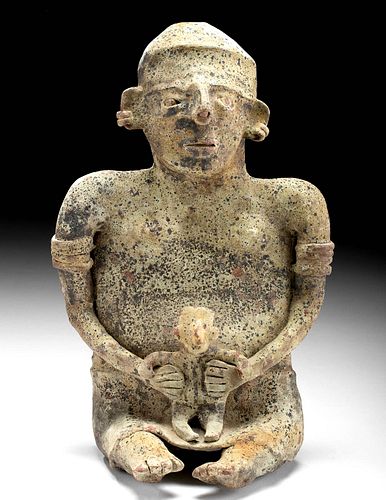Nayarit Pottery Seated Mother w/ Child
Lot 130a
About Seller
Artemis Fine Arts
686 S Taylor Ave, Ste 106
Louisville, CO 80027
United States
Selling antiquities, ancient and ethnographic art online since 1993, Artemis Gallery specializes in Classical Antiquities (Egyptian, Greek, Roman, Near Eastern), Asian, Pre-Columbian, African / Tribal / Oceanographic art. Our extensive inventory includes pottery, stone, metal, wood, glass and textil...Read more
Estimate:
$3,000 - $4,500
Absentee vs Live bid
Two ways to bid:
- Leave a max absentee bid and the platform will bid on your behalf up to your maximum bid during the live auction.
- Bid live during the auction and your bids will be submitted real-time to the auctioneer.
Bid Increments
| Price | Bid Increment |
|---|---|
| $0 | $25 |
| $300 | $50 |
| $1,000 | $100 |
| $2,000 | $250 |
| $5,000 | $500 |
| $10,000 | $1,000 |
| $20,000 | $2,500 |
| $50,000 | $5,000 |
| $100,000 | $10,000 |
| $200,000 | $20,000 |
About Auction
By Artemis Fine Arts
Oct 8, 2020
Set Reminder
2020-10-08 10:00:00
2020-10-08 10:00:00
America/New_York
Bidsquare
Bidsquare : Exceptional Antiquities, Asian, Ethnographic
https://www.bidsquare.com/auctions/artemis-gallery/exceptional-antiquities-asian-ethnographic-5796
Museum-worthy examples of Egyptian, Greek, Roman, Etruscan, Near Eastern, Far East / Asian, Pre-Columbian, African / Tribal,Oceanic, Native American, Spanish Colonial, Russian, Fossils, Ancient Jewelry, Fine Art, so much more! Artemis Fine Arts info@artemisgallery.com
Museum-worthy examples of Egyptian, Greek, Roman, Etruscan, Near Eastern, Far East / Asian, Pre-Columbian, African / Tribal,Oceanic, Native American, Spanish Colonial, Russian, Fossils, Ancient Jewelry, Fine Art, so much more! Artemis Fine Arts info@artemisgallery.com
- Lot Description
Pre-Columbian, West Mexico, Nayarit, ca. 300 BCE to 300 CE. A large hand-built pottery figure of a woman with a child on her lap. The figure sits with the legs pointing outward from under a loincloth and a child seated on her lap. The long skinny arms of the mother grasp the child under its arms. Arm bands wrap around below the shoulders on both sides. The face has a slit mouth, eyes, a hook nose with a nose ring, protruding ears with earrings, and a vent hole on the top of the head leads into the hollow interior. Two nubs indicate the breasts of the mother. The surface is almost entirely coated with the remains of painted black, yellow, and tan pigment that show through the manganese deposits. The most striking details are the painted black designs around the woman’s mouth, suggesting facial tattoos. A large effigy figure capturing an intimate moment between mother and child with wonderful painted details. Size: 7.125" W x 11.75" H (18.1 cm x 29.8 cm)
The pottery figures created by the cultures from the Nayarit area are some of the only art pieces that survive from these people. Without a written language, these statues not only serve an artistic purpose but also a glimpse into their religious beliefs. They were part of the Mesoamerican cultures that practiced the funerary tradition of burials in shaft tombs, and these figures are often found within such graves. These figures may represent ancestors to watch over the deceased. Some scholars have connected these dynamic sculptures of the living as a strong contrast to the skeletal remains whose space they shared, as if they mediated between the living and the dead.
Provenance: private Arcadia, California, USA collection, acquired prior to 2000
All items legal to buy/sell under U.S. Statute covering cultural patrimony Code 2600, CHAPTER 14, and are guaranteed to be as described or your money back.
A Certificate of Authenticity will accompany all winning bids.
We ship worldwide and handle all shipping in-house for your convenience.
#159556Small chip to child’s hand. Surface wear and minor nicks commensurate with age. Mineral deposits and large areas of pigment.Condition
- Shipping Info
-
All shipping is handled in-house for your convenience. Your invoice from Artemis Gallery will include shipping calculation instructions. If in doubt, please inquire BEFORE bidding for estimated shipping costs for individual items.
-
- Buyer's Premium



 EUR
EUR CAD
CAD AUD
AUD GBP
GBP MXN
MXN HKD
HKD CNY
CNY MYR
MYR SEK
SEK SGD
SGD CHF
CHF THB
THB















